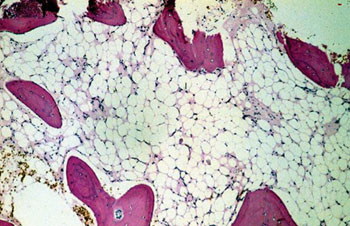Gene Mutation Discovered in Blood Disorder Aplastic Anemia
By LabMedica International staff writers
Posted on 08 Oct 2014
A gene mutation has been discovered that causes aplastic anemia, a serious blood disorder in which the bone marrow fails to produce normal amounts of blood cells.Posted on 08 Oct 2014
Telomerase is a ribonucleoprotein enzyme that is necessary for overcoming telomere shortening in human germ and stem cells. Mutations in telomerase or other telomere maintenance proteins can lead to diseases characterized by depletion of hematopoietic stem cells and bone marrow failure.

Image: Photomicrograph of a hypocellular bone marrow biopsy, due to lack of hematopoietic cells, from a patient with aplastic anemia (Photo courtesy of the Autonomous University of Zacatecas).
Scientists at the Children's Hospital of Philadelphia (PA, USA) working with international colleagues investigated the family of a patient who had presented with severe thrombocytopenia and macrocytosis, and has been diagnosed with aplastic anemia. The family history includes other cases of bone marrow failure, as well as oral carcinoma and leukemia. Peripheral blood DNA was available from the patient, her parents, and maternal grandparents.
Whole exome sequencing was performed and the exonic regions were captured using SureSelect Human All Exon kit (Agilent; Santa Clara, CA, USA) and pair-end sequencing was carried out on HiSeq 2000 machines (Illumina; San Diego, CA, USA). A Telomere Flow-Fluorescence In Situ Hybridization (Flow-FISH) was performed and the subsequent flow cytometry was performed on a FACS CANTO II (BD Biosciences; San Jose, CA, USA). Other complimentary methodologies were also used to corroborate the initial findings.
The 18 year-old patient, her mother and maternal grandmother presented with bone marrow failure of varying severity, and their decreasing ages of presentation in successive generations suggested disease anticipation. The team found that that the mutation in Adrenocortical Dysplasia Homolog gene (ACD) alters the telomere-binding protein tripeptidyl peptidase 1 (TPP1), disrupting the interactions between telomere and telomerase. Without access to telomerase to help maintain telomeres, blood cells lose their structural integrity and die, resulting in bone marrow failure.
Hakon Hakonarson, MD, PhD, the director of the Center for Applied Genomics, and study co-leader, said, “Identifying this causal defect may help suggest future molecular-based treatments that bypass the gene defect and restore blood cell production. This improved understanding of the underlying molecular mechanisms may suggest new approaches to treating disorders such as aplastic anemia. For instance, investigators may identify other avenues for recruiting telomerase to telomeres to restore its protective function.” The study was published on September 9, 2014, in the journal Blood.
Related Links:
Children's Hospital of Philadelphia
Agilent
Illumina














